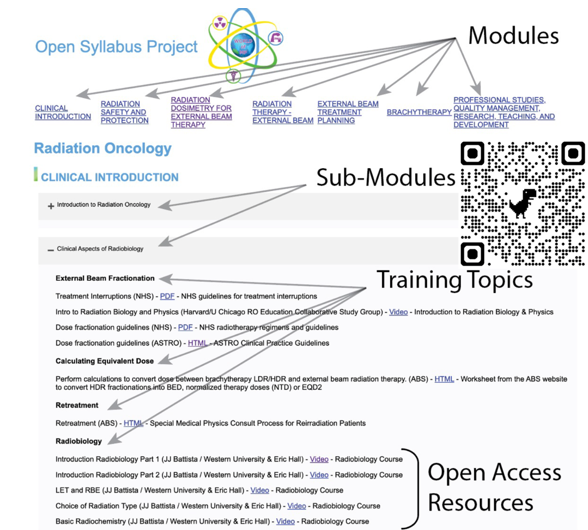ESTRO Meets Asia 2024 Congress Report
Gaining access to quality educational content and resources is a significant challenge for medical physics trainees in low and middle-income countries. To achieve competency in medical physics practice, students must be exposed to and master medical physics standards of practice, most of which are encapsulated in curricula defined by bodies such as the Commission on Accreditation of Medical Physics Education Programmes and the International Atomic Energy Agency (IAEA). Although there is a wealth of freely accessible educational content, no generalised hierarchical syllabus directly links core medical physics competencies with online content. This work aims to share and demonstrate a new resource, WORLD of Medical Physics, which was developed by Medical Physics for World Benefit (MPWB) volunteers. It is based on the IAEA TC-37 report Clinical Training of Medical Physicists Specializing in Radiation Oncology, which was designed to meet this challenge.
Over five years, a global team of dedicated volunteers has compiled a compendium of medical physics resources. The learning objectives, core competencies, and training topics for each of the eight major learning modules (clinical introduction, radiation safety and protection, Radiation dosimetry, Radiation therapy, External beam treatment planning, brachytherapy and professional studies/quality management/research/teaching and development) in the IAEA TC-37 report were meticulously gathered in a master spreadsheet. These training topics were then thoughtfully linked to freely accessible resources, which include digital documents (PDFs), presentations, websites, videos, podcasts, and web pages. Contributions from medical physics educators are welcomed, as they can licence their work through the creative commons and have content hosted on local MPWB servers, fostering a sense of global collaboration and shared knowledge (Figure 1).

Figure 1: WORLD of Medical Physics webpage. The “+” symbols indicate modules with submodules. The user can navigate the modules vertically or horizontally (via hyperlinks). The submodules are then linked to an open-access resource. The QR code on the figure directs the reader to the website's front page, where users can access WORLD of Medical Physics with or without a search tool.
The TC-37 report covers approximately 780 separate training topics. Approximately 492 links to open-access external resources (hosted on the internet) and 104 links to internal resources (accessible via a local server) were meticulously matched. This process has ensured that all aspects of medical physics practice are covered. All training topics, links to the resources, and associated meta-data are managed through a single, editable, living spreadsheet, which is a reassuringly comprehensive and up-to-date resource. Since its release in May 2023, the website has had over 5000 views and this figure is steadily increasing as more residents become aware of this resource. A small survey of residency programmes (N=6) reported the resource as very useful (86%).
The Website of Open Resources for Learning and Development of Medical Physics platform holds immense promise, though it is in its early stages. It can potentially democratise trainees' access to critical educational content, particularly given its organisational simplicity and reference to the IAEA TC-37 training document. We encourage everyone to visit the website, share it and to offer suggestions. Visit https://www.mpwb.org/WorldOfMedicalPhysics to learn more.

Parminder S. Basran, Ph.D., FCCPM, FAAPM
Cornell University, Ithaca, USA
psb92@cornell.edu
@medphyswb